
If you're ready to fully commit to your health, then investing in a piece of at-home fitness equipment is an awesome idea. But you might be wondering, which is better: an exercise bike or a treadmill?
In this ultimate gym machine showdown, there are many things to consider. What is better for your body? What is the best exercise bike out there? How about the best or most affordable treadmills? What gives you the best training? What torches calories faster, and what is more fun?
The answers differ for everyone depending on individual goals and workout preferences, but have no fear! The ACTIVE Reviews Team is here to help you wade through the details and make the best decision.
Why Trust Us?
ACTIVE.com's editorial team relies on the knowledge and experience of fitness and wellness experts including competitive athletes, coaches, physical therapists, nutritionists, and certified trainers. This helps us ensure the products we feature are of the highest standard. Collectively, the team has spent countless hours researching equipment, gear, and recovery tools in order to create the most accurate, authentic content for our readers. Customer satisfaction is also a key part of our review process, which is why we only feature products that are highly rated.
Our Top Picks
Exercise Bikes
Treadmills
Exercise Bikes vs.Treadmills: The Basics
It can be an overwhelming choice when you're in the market for a treadmill or exercise bike. This basic overview is a good place to start.
Exercise Bikes
- Calories burned: You will burn less calories on an exercise bike than on a treadmill.
- Space: Most exercise bikes will take up less room than a treadmill. Many are lightweight enough to move and store as needed.
- Features: Like most motorized treadmills, an exercise bike will have displays, tracking options, and interactive games or classes to try. Bikes are also quieter than treadmills, with the exception of the air bike, which sounds like a wind machine.
- Price: Exercise bikes are cheaper than treadmills and range in price from $200 to $1,000.
- Best for: Exercise bikes are best for people looking for a low-impact way to improve their cardio, athletes recovering from injury, and anyone who loves spin classes.
- Ease of use: It's very user friendly and just about anyone can hop on the bike and control resistance and speed.
- Injury risk: Very low.
- Muscles worked: Primary muscles targeted include the quads, hamstrings, calves, and glutes. Your upper body and core will also see some benefits.
Treadmills
- Calories burned: The number of calories burned on any exercise machine will depend on your weight, exercise intensity, and speed. With that being said, using a treadmill will burn about two times as many calories in the same period of time than an exercise bike.
- Space: While folding treadmill options are available, treadmills are heavier than bikes and will take up more space.
- Features: Luxury treadmills will come with impressive displays, tracking options, and even interactive routes, games, and apps.
- Price: Motorized treadmills are more expensive. On average, treadmills start at $200 and can be priced higher than $2,500.
- Best for: People looking to lose weight, runners training through winter or summer, and people who enjoy walking or running.
- Ease of use: Manual treadmills can be tricky to the inexperienced athlete. Motorized treadmills are very easy to walk or run on. However, studies have shown that motivation to use them is the most difficult part.
- Injury risk: Low to moderate. As long as you are adhering to safe training practices (i.e., not setting the pace too high and not running or walking for too long for your fitness level) the treadmill is a safe way to train.
- Muscles worked: Primarily targets the quads, hamstrings, glutes, calves, hip flexors. Secondary muscle groups worked are abs and arms.
Exercise Bikes
There are many reasons why any athlete should own an exercise bike. They provide a convenient way to keep your fitness in gear year-round. Spin class enthusiasts, HIIT lovers, outdoor cyclists, and people getting over injury can all benefit from having a stationary bike right in their own home. We examined the specs and reviews of several different exercise bikes and came up with the following recommendations.
Nordictrack Studio Bikes
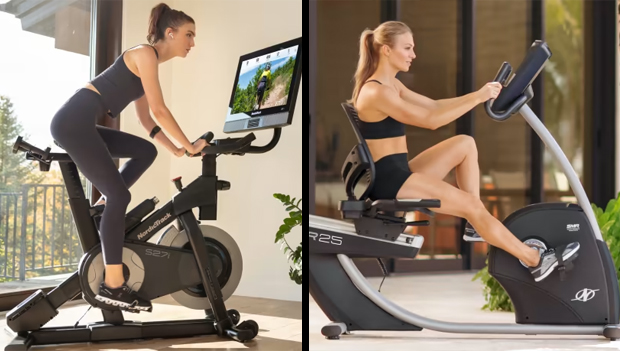
Nordictrack is the gold standard of exercise machinery. Their cutting-edge tech and reliable, durable equipment has been the go-to for at-home gyms for years.
The studio bike series has it all: inclines, declines, ample resistance options, touchscreen display, and the ability to stream fitness classes with automatic trainer control (meaning you just do the work and let the class control the intensity). Plus, it's small, sleek, and can go in many spaces.
What We Like
- Interactive fitness class streaming options
- Easy-to-use touchscreen display that rotates
- Small physical footprint
What We Don't Like
- Pricey! Ranges from $1,000 to $2,500
- Must have an iFit subscription for classes
- Interface is a little cumbersome when it comes to finding classes
Horizon Indoor Cycles
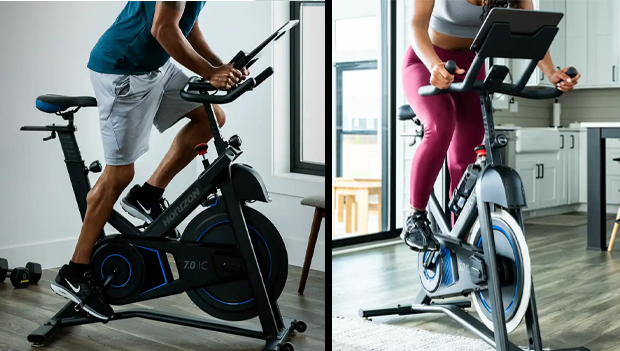
Intuitive, easy-to-use, and super fun, any Horizon Indoor Cycle will motivate you to pedal hard each day. We also love that you don't have to break the bank to have one in your home. Starting at just under $600, this is a great machine that doesn't skimp on quality despite the low price.
What We Like
- Affordable price
- Quiet and smooth
- Works with a variety of apps for interactive classes
What We Don't Like
- It doesn't have the autocontrol option (doesn't automatically sync with an instructor's resistance/route)
- Lower weight capacity—can only hold a 250-lb. or 300-lb. person depending on the model
Proform Studio Series
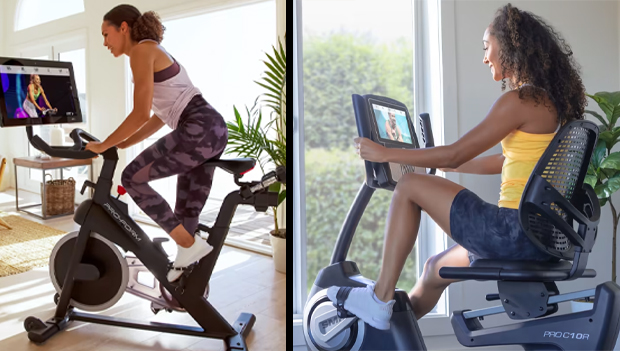
We absolutely loved getting our heart rates to the max on the Proform bikes. It's easy to assemble, feels stable, doesn't take up much room, and lets you follow along with interactive classes. Plus, it comes with dumbbells for full-body fitness.
What We Like
- Smooth and quiet ride
- Trainer-controlled resistance option
- Easy to assemble, adjust, and move
What We Don't Like
- This is a bring-your-own-tablet machine, so the cost doesn't include a screen
- Lower weight capacity, at 250 lbs.
Treadmills
If you are someone who is looking to train for a race inside or wanting to drop some pounds, a treadmill is an incredible option. Thanks to technology, these machines are smoother than ever and feature routes, classes, and coaches that will motivate and inspire you to log miles every day. Here are our favorites.
Nordictrack Treadmills

There is a reason why Nordictrack has won accolades for being the best overall treadmill. First, there's nothing boring about working out on these machines. You have the choice to join a treadmill studio class or follow a coach on a trainer-led global trek. It will feel like you are actually there thanks to the large LED touchscreen.
The motor is quieter than ever and self-cooling. Plus, Nordictrack treadmills are known for their durability and reliability, letting you worry about the workout and not the maintenance.
What We Like
- Trainer-led classes for a variety of preferences, complete with trainer-controlled incline and speed adjustments
- Personalized training options
- Smooth and easy to use
What We Don't Like
- Classes require an iFit subscription
- Very expensive, starting at $2,000
Horizon Treadmills
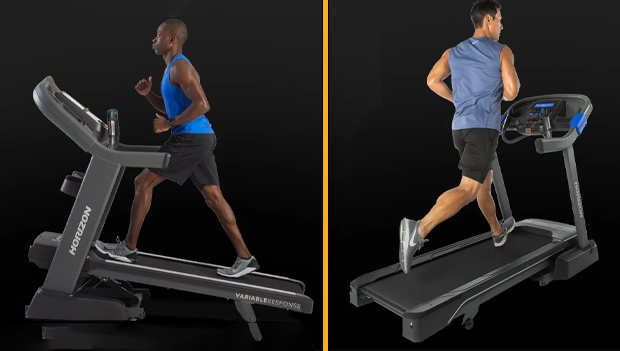
Horizon is always looking to improve treadmill function while keeping the cost low. The motor in these machines really allows for smooth running and can handle a lot of weight and pounding. It's more basic than some of the other treadmills on the market, meaning it doesn't come with a huge touchscreen or electronic extras, but for some reviewers, that's exactly what makes it ideal.
What We Like
- The rapid-sync motor tech lets you transition speeds seamlessly without a lag
- Affordable
- It's sturdy and good for taller and heavier people
What We Don't Like
- Some people say its size is overwhelming and it requires a lot of space
- There are some glitches when it comes to heart rate reporting and other metrics
BUY: Horizon Treadmills
Proform Treadmills

Proform treadmills have the reputation of being reliable and affordable. They are also easy to use and smaller than some of the other options on the market. We particularly like that it can be set up without professional installation within two hours.
What We Like
- Easy to set up and use
- Some models are foldable
- Smooth and absorbs impact
What We Don't Like
- Some customers experienced manufacturing flaws that needed to be addressed before use
- Some can be loud and a little squeaky
BUY: Proform Treadmills
What Are Treadmills?
A treadmill is an exercise machine that allows you to run or walk while staying in one place. It works by using a belt under the user's feet that is a continuous loop. The movement of the belt is powered by an internal motor or by the user.
Treadmills came about more than 200 years ago with the first models made in England. Now, more than 51.8 million people in the U.S. use treadmills willingly. They are a convenient, efficient, and versatile way to enhance your cardiovascular fitness.
Types of Treadmills
Not all treadmills are the same. They come in many shapes and forms with many different features.
- Motorized: Motorized treadmills are commonplace in mainstream gyms. You power these on, and the electrical motor starts humming and moving the looping belt beneath you. You can adjust the speed and incline, and luxury models will include an elegant display with options to track training metrics and virtually take you on routes around the world.
- Manual: Manual treadmills make you do all the work. The belt is propelled by your lower body, and you control the pace. Trainers and coaches love these because they more closely resemble traditional running. Plus, many models are cheaper. But if your form is off, or you just want to stroll, these can be tough to use.
- Hybrid: First, there is a hybrid that offers the functions of both a motorized and manual treadmill. There is another hybrid, sometimes called a "tread climber," which is pretty nifty for people who want variety. These machines will function as a traditional treadmill and convert into either ellipticals or stairclimbers.
- Foldable: Great for apartment dwellers or people who just don't want a treadmill out in plain sight, foldable treadmills function just like a normal treadmill but fold up when not in use.
What We Like About Treadmills
- A treadmill gives you access to fitness any time, no matter the weather. For so many of us, the difference between hitting or missing miles comes down to time. And even if we did have enough time, running or walking in those prime hours when the weather is nice and it's safe can prove impossible.
- You can focus on your form. Without outdoor distractions and variables, you can really get a grip on what your body is doing when you are walking or running. Take inventory: Are your shoulders relaxed? What is your arm swing like? Are you bouncing too much? What about your knee drive? A physical therapist can give you individualized tips, but even without professional knowledge, you might be able to fix quirks and tension to make your form more efficient.
- The tech is game-changing. Many treadmill models feature incredible displays that offer routes or games to help get you through your workout. For runners, some can simulate popular race courses to give you a sneak peek before your goal race. Even the most basic models give you the option to change resistance or elevation, allowing you to target different muscles and work toward any fitness goal.
What We Don't Like About Treadmills
- They can be boring. You might have heard running enthusiasts call the treadmill a "dreadmill," and it's true that sometimes the monotony of running in one place on a loop can turn into a chore.
- Your form can change. Runners should note that treadmill use can alter the biomechanics of your stride. As we mentioned above, this could be a benefit if you are focusing on a flaw in your form, but an unintentional change could lead to inefficiencies and even injuries.
- Your rate of perceived exertion can become skewed. Compared to walking or running outside, one study shows that a treadmill will feel harder. So while you might think you are exerting the same energy as you are in a session of the same length or distance, your sweat session outside will actually be the harder effort.
- They're high impact. Impact is another issue to be mindful of, whether you plan to walk or run on your treadmill. If you are dealing with a nagging pain or injury that requires rest from high-impact sports, an exercise bike might be the way to go.
What Are Exercise Bikes?
An exercise bike is a piece of training equipment that is similar to a regular bike but stationary. All versions of these stationary bikes will have a seat, pedals, and handles. Indoor cycling is an awesome low-impact exercise to help your cardiovascular fitness.
In 1741, orthopedics was emerging as a science. Inventors came up with a contraption that resembled an exercise bike to work the joints. It was called the Gymnasticon, and it was actually developed to help people without mobility work their muscles. In 1932, the Exercycle, which was something resembling what we know as an exercise bike, became a popular method of training.
Types of Exercise Bikes
- Upright Stationary Bike: The upright stationary bike is very similar to a regular, free-moving bicycle. It has a flywheel, bicycle seat, and handles. Most of these bikes offer options to change resistance and will have a screen to help track your distance, calories expended, speed, power, and heart rate.
A subcategory of upright bikes is the studio bike, which has been popularized by the likes of Soul Cycle and other indoor cycling classes. These bikes have a slightly higher seat than the standard stationary bike. Many of these will also come with pedals that allow you to "clip in" with special shoes, similar to what outdoor cyclists and mountain bikers do.
These types of bikes are compact. Many are lightweight nowadays, and some even fold.
- Recumbent Bike: A recumbent bike has an actual chair-like seat that is lower to the ground. The pedals are set slightly in a more reclined position in front of the seat. This is a more comfortable option for people with injuries, mobility issues, and seniors.
- Air Bike: Whew, get ready for a workout. On an air bike, the seat and pedals are the same as on a traditional bike, but the handlebars move, as well. Both the pedals and handlebars are attached to the fan, so your entire body is working on this machine. While these are often used in HIIT classes, they are a great low-impact way to torch calories even when used in a more traditional way.
What We Like About Exercise Bikes
- It's a great low-impact workout. Anyone who's ever suffered a shin splint or knee strain will recall their physical therapist telling them to jump on a stationary bike to keep your cardio in check while healing, and that's because cycling is a great way to work out without putting strain on your body.
- It's an incredible lower-body workout. Your quads, hammies, calves, and glutes will thank you for the extra gains.
- The technology makes training fun. Newer bikes will let you sweat it out in a group setting, rise to the top of the leaderboard, and basically live your virtual Tour de France dreams from the comfort of your garage.
What We Don't Like About Exercise Bikes
- They won't burn as many calories as treadmills. With the exception of HIIT sessions on an air bike, if you bike and run for the same amount of time, you're going to end up doing more work on a treadmill. The cardio gains are just better if you're standing and using your entire body.
- For cyclists, a stationary bike is not the same as outdoor cycling. Even with resistance changes, you cannot train solely indoors if you want to improve your outdoor bike. The weather, air, wind, hills, and turn are all factors that are stripped away when training inside.
- A stationary bike is just that—stationary. Some people will not like staying in one place doing the same thing for 30-60 minutes. And, if you are on an upright or studio bike, that seat might start to hurt your booty. It's definitely worth exploring how much you love cycling before investing in one of these.
How to Decide Between an Exercise Bike vs. a Treadmill
Now you have the pros and cons to help you make an informed decision. Should you go with the calorie-torching treadmill or strengthen your quads on an exercise bike? The answer really depends on you, your space, your wallet, and your training goals. Ask yourself the following questions:
What is your budget?
Stationary bikes, on average, are less expensive than treadmills. Bikes are typically $200 to $1,000. Treadmills start at $200 and can go upwards of $2,500. The cheapest of the cheap options in both categories tend to have ease-of-use issues and durability problems, so you probably want to go a little more toward the midrange if your budget allows.
Where will this equipment go?
Space is going to be an issue with a giant $3,000 treadmill. If you have a large home gym, that's great—invite the rest of us over! If you are trying to squeeze a convenient machine into a studio apartment, a bike is going to be the best option.
What are my training goals?
If you are looking to drop a few pounds, a treadmill will get you there faster than a stationary bike with consistent use. If you're wanting to train for a race, a treadmill will be more useful than a bike.
If you are recovering from injury, supplementing a sport or outdoor running, maintaining fitness, or want something low-impact but fun, the bike option is the way to go.
At the end of the day, you have to be honest with yourself and choose the one you will use the most. So that might mean figuring out which will be easiest to use when your motivation is low and which will bring you joy.
FAQs About Exercise Bikes vs. Treadmills
Is a treadmill or exercise bike better for belly fat?
To shed pounds from any area of your body, you need to burn calories and get your heart rate up. Getting rid of belly fat is possible through cardio—which both an exercise bike and treadmill are made for. A treadmill is more efficient at burning calories, so this is the best choice if your primary goal is burning belly fat.
Is 30 minutes on an exercise bike enough?
Using an exercise bike for 30 minutes per day will help your cardiovascular health tremendously. Whether or not it is "enough" depends on your weight, fitness levels, and goals. If you are just getting started on a new exercise program, 30 minutes is an awesome amount. This is especially true if you are doing intervals and including strength-training moves. As you get stronger and fitter, you can increase the time and intensity.
How long does it take to see results on an exercise bike?
If you are looking for results in your physical appearance, then you will likely notice changes after just one month of using an exercise bike. Remember that diet and other lifestyle changes can hasten this timeframe. You will also feel results within days or a week, including having an uplifted mood, better stamina, and a more positive outlook. Don't be discouraged if you don't immediately see improvements in your physical appearance—the work you put in will be visible soon enough and so worth it.
Do you lose more weight running on a treadmill or outside?
If you look at studies that measure how many calories you burn running outside versus running on a motorized treadmill, you'll see that you will burn about 3% to 7% more outside than inside. Not only does the treadmill's motor help propel you forward, but you are shielded from elements like heat, wind, and humidity, which all factor into heart rate and exertion. With that being said, you have to think about how likely you will be to complete your workout if it's too hot, cold, rainy, or humid. After all, an indoor run is better than no workout at all! And you can always adjust your resistance and speed to burn more calories.
About the Author

Ali Nolan is the author of Master the Marathon: The Ultimate Training Guide for Women. She is the former features editor for Runner’s World and has written for Women’s Running, Self, Sport Literate, and Livestrong. Ali has been featured as a running expert on Good Morning America with Amy Robach, as well as the podcasts 8020 Endurance, I'll Have Another with Lindsey Hein, and Greenletes.
Get ACTIVE on the Go


Couch to 5K®
The best way to get new runners off the couch and across the finish line of their first 5K.
Available for iOS | Android





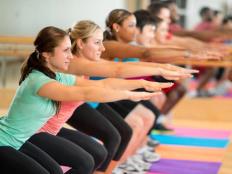


Discuss This Article